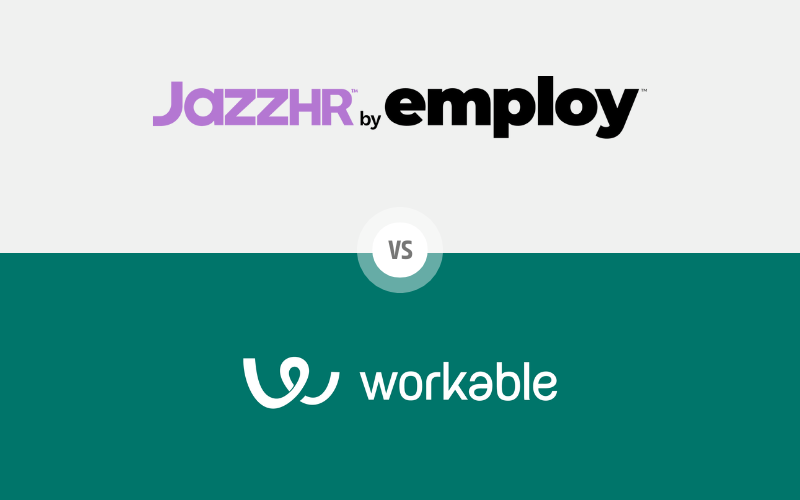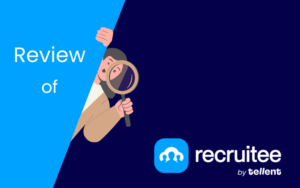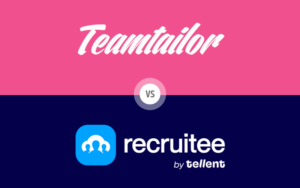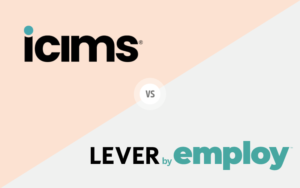Choosing between JazzHR vs Workable can be challenging for businesses looking for the right applicant tracking system to streamline their hiring process. Both platforms offer powerful tools to help recruiters manage job postings, track candidates, and automate tasks, but they cater to different types of organizations. In this comparison, we’ll take a detailed look at their features, pricing, integrations, and more to help you decide which ATS best fits your hiring needs.
Table of Contents
User Interface and User Experience
When comparing JazzHR vs Workable in terms of user interface (UI) and user experience (UX), it’s important to understand how each platform supports recruiters and candidates through intuitive design, navigation, and ease of use. Both platforms aim to streamline the recruitment process, but their approaches differ significantly, catering to different types of organizations.
JazzHR User Interface and User Experience
JazzHR is designed with simplicity in mind, making it a great option for small to mid-sized businesses or companies that don’t require overly complex hiring workflows. The platform is built to provide a straightforward and intuitive experience for recruiters, with a clean layout and logical navigation that minimizes confusion.
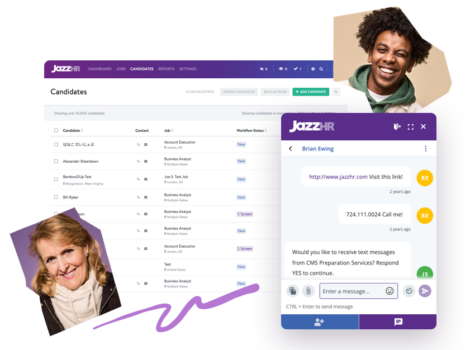
Key Features of JazzHR UI/UX:
- Simplicity: JazzHR’s interface is clean and clutter-free, allowing recruiters to easily access key features such as open job listings, candidate pipelines, and reporting tools. The minimal learning curve ensures teams can get up to speed quickly.
- Customizable Dashboards: Users can personalize their dashboards to focus on the tasks that matter most. This helps teams streamline their workflows and improve productivity, though the customization options are more basic compared to Workable.
- Mobile-Responsive Web Interface: JazzHR’s web platform is fully mobile-responsive, allowing recruiters to manage tasks from smartphones and tablets. However, the absence of a dedicated mobile app could be a drawback for users who prefer app-based management.
- Candidate-Centric Design: JazzHR emphasizes simplifying the application process for candidates. With a focus on reducing friction, candidates can apply for jobs in just a few clicks or by uploading resumes from cloud storage services, helping to reduce drop-off rates.
Workable User Interface and User Experience
Workable offers a more advanced and feature-rich interface, designed to handle high-volume recruiting and complex hiring processes. The platform includes powerful tools aimed at improving recruiter productivity and enhancing candidate engagement. While Workable provides more functionality than JazzHR, it may feel more complex for new users due to the abundance of features.
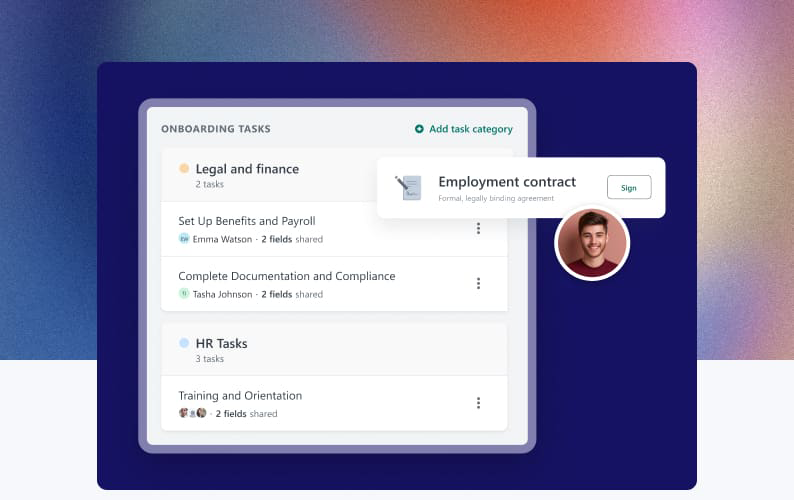
Key Features of Workable UI/UX:
- Advanced Dashboard: Workable’s dashboard provides a comprehensive view of all recruitment activities, including a visual candidate pipeline that tracks applicant progress. Recruiters can easily see where candidates are in the hiring process and quickly identify any bottlenecks.
- AI-Powered Recommendations: Workable uses AI to recommend candidates based on job descriptions and previous hiring data, saving recruiters time and effort. The AI also helps optimize job descriptions to attract more qualified applicants.
- Mobile App: Unlike JazzHR, Workable offers a dedicated mobile app for iOS and Android. The app allows recruiters to manage job postings, review candidates, and communicate with their teams on the go, making it highly convenient for busy hiring managers.
- Candidate Experience Personalization: Workable enables companies to customize their application process and career pages to reflect their brand. The platform offers automated communication tools to keep candidates informed, enhancing the overall experience.
Comparison and Conclusion
Choosing between JazzHR vs Workable for User Interface and User Experience depends on your organization’s size, hiring needs, and preference for simplicity versus advanced features.
In summary:
- JazzHR is best suited for small to mid-sized businesses looking for a simple, intuitive interface. Its clean design, customizable dashboard, and mobile-responsive web platform make it ideal for teams that want to streamline their recruitment process quickly and efficiently.
- Workable is better for larger organizations or those handling high-volume hiring. Its advanced dashboard, AI-powered features, and dedicated mobile app provide powerful tools for more complex recruitment workflows, though it may require more time for onboarding.
Ultimately, the decision between JazzHR vs Workable comes down to whether you prioritize a simple, easy-to-use platform or a more feature-rich solution. For smaller teams, JazzHR is a practical choice, while larger organizations will likely benefit from the robust functionality Workable offers.
Core ATS Functions
A robust applicant tracking system (ATS) must deliver essential tools that help recruiters streamline job postings, manage incoming applications, and screen candidates efficiently. When comparing JazzHR vs Workable in terms of core ATS functions, both platforms cover the basics but offer different approaches to job distribution, resume parsing, and sourcing candidates.
JazzHR Core ATS Functions
JazzHR offers a comprehensive set of core ATS features aimed at small to mid-sized businesses that need efficient, easy-to-use tools for managing their hiring processes. The platform focuses on simplifying job postings, automating resume screening, and providing sourcing tools to find quality candidates faster.
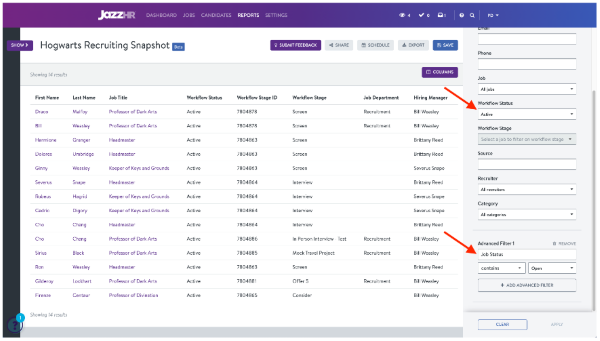
Key Features of JazzHR Core ATS Functions:
- Job Posting and Distribution:
JazzHR allows users to post job openings to multiple job boards with just a few clicks. The platform integrates with popular job boards such as Indeed, Glassdoor, and LinkedIn, ensuring broad visibility for open positions. Recruiters can also customize job postings to fit different platforms, optimizing them for each channel. JazzHR’s customizable workflows make it easy to manage job requisitions and approvals, ensuring that new positions are posted quickly and accurately. - Resume Parsing and Screening:
JazzHR’s resume parsing tool automatically extracts key information from submitted resumes, such as contact details, skills, and work experience, reducing the need for manual data entry. The platform then matches candidates to job requirements using customizable filters and keywords, helping recruiters quickly identify the most relevant applicants. The system also offers automated screening questions, allowing recruiters to disqualify unqualified candidates early in the process. This feature helps save time and ensures that only the most suitable candidates move forward in the hiring pipeline. - Candidate Sourcing Tools:
JazzHR provides various sourcing tools to help recruiters attract talent. In addition to job board integrations, the platform offers a candidate database where recruiters can store and search for previous applicants. The platform also includes a referral tracking system, allowing employees to refer potential candidates and track the success of their referrals. However, JazzHR’s sourcing tools may feel limited compared to Workable’s more advanced capabilities, particularly for organizations that rely heavily on proactive candidate sourcing.
Workable Core ATS Functions
Workable is designed to handle high-volume recruiting and offers a more sophisticated set of core ATS features. The platform emphasizes automation, AI-powered tools, and integrations with a wider range of sourcing channels to help recruiters find the best candidates faster.
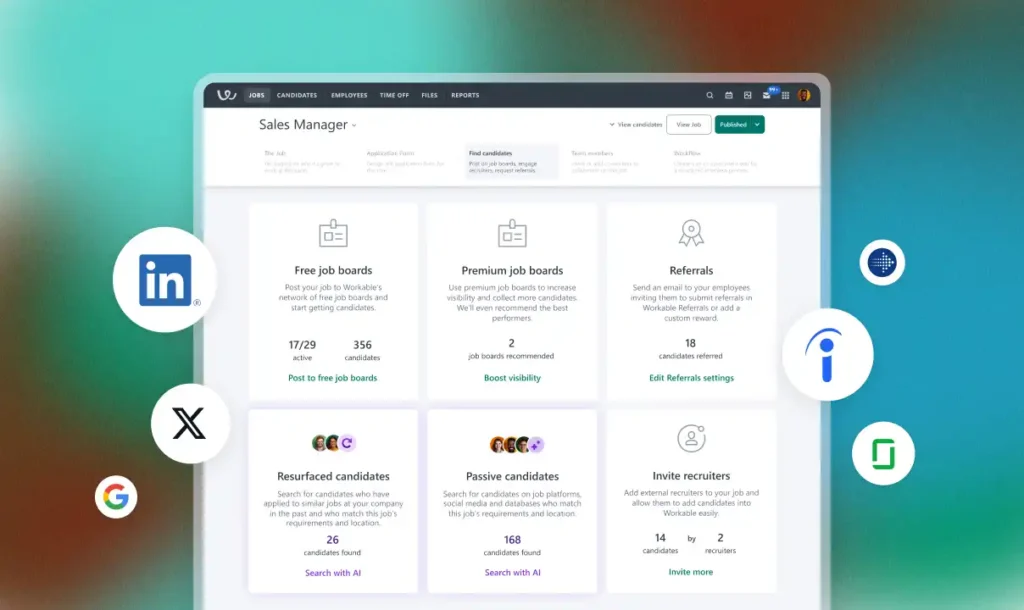
Key Features of Workable Core ATS Functions:
- Job Posting and Distribution:
Workable offers an extensive job board network, including integrations with over 200 job boards globally. The platform provides one-click job distribution, allowing recruiters to post openings to multiple channels simultaneously, including niche and regional job sites. One standout feature of Workable is its built-in job description optimization tool, which uses AI to suggest improvements to job postings. This can help recruiters create more effective job ads that attract higher-quality candidates. - Resume Parsing and Screening:
Workable’s resume parsing tool is highly efficient, automatically extracting key details from resumes and storing them in a structured format. The platform also uses AI to rank candidates based on their suitability for the role, helping recruiters focus on top applicants without manually sorting through large volumes of resumes. In addition to parsing resumes, Workable offers customizable screening questions and automated disqualification rules. This feature ensures that unqualified candidates are filtered out early in the process, saving recruiters time. - Candidate Sourcing Tools:
Workable excels in candidate sourcing, offering tools that go beyond job board postings. The platform includes a People Search feature, which helps recruiters find passive candidates by searching publicly available profiles across the web. Workable also integrates with social media platforms and professional networks, making it easier for recruiters to reach out to potential candidates directly. The platform’s sourcing tools are particularly valuable for companies that rely on proactive recruiting strategies.
Comparison and Conclusion
When comparing JazzHR vs Workable in terms of core ATS functions, both platforms cover essential hiring tasks, but their approaches differ based on the size and complexity of the recruiting team.
In summary:
- JazzHR is ideal for small to mid-sized businesses that need a straightforward system to manage job postings, parse resumes, and automate screening processes. The platform’s ease of use and customizable workflows make it a practical solution for teams that want to get up and running quickly.
- Workable is better suited for larger organizations that handle high-volume recruiting and need more advanced sourcing tools. Its AI-driven features, extensive job board integrations, and proactive sourcing capabilities make it a powerful solution for teams focused on finding top talent efficiently.
Ultimately, the decision between JazzHR vs Workable for core ATS functions depends on your organization’s recruiting needs. If simplicity and ease of use are priorities, JazzHR is a solid choice. If you need more sophisticated tools to find and engage top talent, Workable’s advanced features are worth considering.
Applicant Management
Effective applicant management is a core function of any applicant tracking system (ATS). When comparing JazzHR vs Workable, both platforms offer tools to help recruiters track, organize, and communicate with candidates throughout the hiring process. However, their approaches differ in terms of visualizing candidate pipelines, managing communication, and scheduling interviews.
JazzHR Applicant Management
JazzHR provides a straightforward, easy-to-use system for managing candidates through every stage of the hiring process. The platform focuses on simplicity, making it an excellent option for small to mid-sized businesses that want to streamline their applicant management without unnecessary complexity.
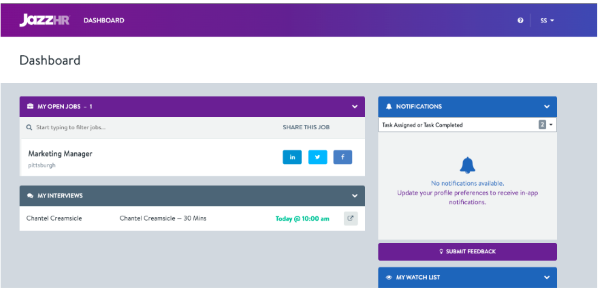
Key Features of JazzHR Applicant Management:
- Candidate Pipeline Visualization:
JazzHR’s pipeline view allows recruiters to see where candidates stand in the hiring process. The visual workflow makes it easy to move applicants between stages, such as initial screening, interviews, and offers. Recruiters can customize pipeline stages to fit their specific hiring process, ensuring the system adapts to their needs. While JazzHR’s pipeline is simple and easy to use, it may lack the advanced visualization and analytics capabilities that larger organizations might need. - Communication Tools (Email, SMS, etc.):
JazzHR offers built-in email templates and automated messaging, allowing recruiters to communicate with candidates efficiently. The platform integrates with popular email services like Gmail and Outlook, making it easy to keep communication in one place. JazzHR also provides bulk messaging capabilities, enabling recruiters to send updates or requests to multiple candidates at once. However, the platform does not natively support SMS communication, which can be a drawback for recruiters who prefer to text candidates. - Interview Scheduling:
JazzHR includes interview scheduling tools that allow recruiters to coordinate interviews directly through the platform. The system integrates with calendar tools like Google Calendar and Outlook, making it easy to sync schedules and avoid conflicts. While the interview scheduling feature is useful, JazzHR’s offering is more basic compared to Workable, which provides additional automation and flexibility in this area.
Workable Applicant Management
Workable’s applicant management tools are designed for high-volume recruiting and offer more advanced features for organizing candidates, managing communication, and automating scheduling tasks. The platform prioritizes efficiency and scalability, making it well-suited for larger organizations or recruitment agencies.
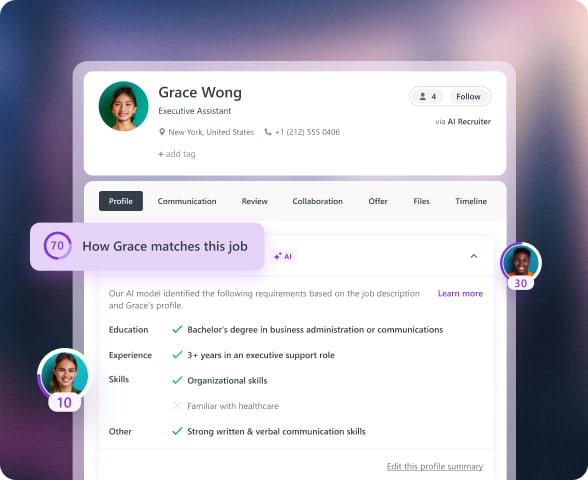
Key Features of Workable Applicant Management:
- Candidate Pipeline Visualization:
Workable’s visual pipeline is highly customizable and offers drag-and-drop functionality, allowing recruiters to move candidates between stages with ease. The platform provides detailed insights into pipeline metrics, such as time-to-hire and drop-off rates at each stage, helping teams optimize their recruitment processes. One standout feature of Workable is its automation rules, which can trigger specific actions based on candidate progress. For example, candidates who reach a certain stage can automatically receive follow-up emails or be flagged for further review. - Communication Tools (Email, SMS, etc.):
Workable offers built-in email and SMS communication, providing more options for recruiters to connect with candidates. The platform also includes automated follow-ups and customizable templates, ensuring that communication remains consistent and efficient. The SMS feature is particularly useful for engaging candidates quickly, especially in industries where speed is critical. Workable’s centralized messaging hub ensures that all candidate interactions are tracked in one place, reducing the risk of missed communications. - Interview Scheduling:
Workable’s interview scheduling tool is more advanced compared to JazzHR. It includes self-scheduling links that allow candidates to choose a time that works best for them based on the recruiter’s availability. This feature reduces the back-and-forth typically involved in scheduling interviews and helps speed up the hiring process. Additionally, Workable integrates with major calendar tools and video conferencing platforms like Zoom, enabling recruiters to manage both in-person and virtual interviews seamlessly.
Comparison and Conclusion
When comparing JazzHR vs Workable for Applicant Management, both platforms provide essential tools to manage candidates, but they differ in terms of automation, customization, and communication options.
In summary:
- JazzHR is best suited for small to mid-sized businesses that need a simple, user-friendly applicant management system. Its visual pipeline, built-in email tools, and interview scheduling features are easy to use, but the lack of SMS communication and advanced scheduling options may be limiting for some recruiters.
- Workable is better for larger organizations or teams handling high-volume recruiting. Its customizable pipeline, integrated SMS communication, and self-scheduling interview tools provide more advanced functionality, helping recruiters manage candidates more efficiently.
Ultimately, the decision between JazzHR vs Workable for applicant management comes down to the size of your organization and your need for advanced automation. JazzHR provides a straightforward approach that works well for smaller teams, while Workable offers more sophisticated tools that can handle the complexities of large-scale recruiting.
Recruitment Marketing
Effective recruitment marketing tools are essential for attracting the right candidates and building a strong employer brand. When comparing JazzHR vs Workable, both platforms offer features to help companies promote their job openings, enhance their career sites, and leverage social media to reach more candidates. However, the platforms differ in terms of the depth and flexibility of their recruitment marketing tools.
JazzHR Recruitment Marketing
JazzHR offers a range of recruitment marketing features designed to help small to mid-sized businesses improve their job visibility and attract quality candidates. The platform focuses on simplifying job promotion and career site customization while providing basic tools for employee referral programs.
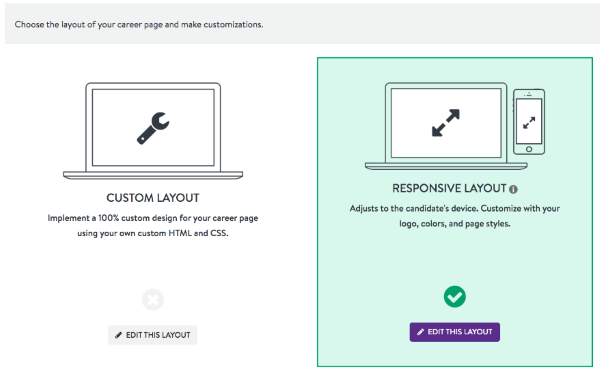
Key Features of JazzHR Recruitment Marketing:
- Career Site Builder:
JazzHR includes a built-in career site builder that allows companies to create branded career pages to showcase job openings and promote their employer brand. The site builder is easy to use and offers customization options to match a company’s branding. Companies can choose from several templates, customize colors, logos, and content, and add job listings directly from the JazzHR platform. While the career site builder is functional and user-friendly, it may lack some of the advanced customization features offered by Workable. - Social Media Integration:
JazzHR makes it easy to share job postings directly to social media platforms, including LinkedIn, Facebook, and Twitter. Recruiters can schedule and automate job postings to ensure consistent promotion across various channels. However, JazzHR’s social media tools are more basic compared to Workable, with fewer options for tracking engagement and performance metrics from social media campaigns. - Employee Referral Programs:
JazzHR includes a referral tracking feature that allows employees to refer candidates for open positions. The system tracks referrals, making it easy for recruiters to see which referrals are successful and reward employees accordingly. While this feature is helpful for companies looking to increase referrals, the referral program in JazzHR is more basic and lacks the gamification and engagement tools found in some other platforms.
Workable Recruitment Marketing
Workable offers a more comprehensive suite of recruitment marketing tools that are designed for companies handling high-volume hiring or looking to enhance their employer brand. The platform focuses on creating attractive career sites, leveraging social media for job promotion, and offering tools to boost employee referrals.
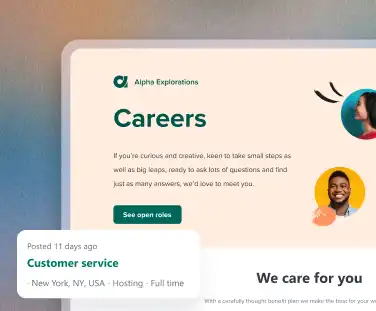
Key Features of Workable Recruitment Marketing:
- Career Site Builder:
Workable’s career site builder is more advanced than JazzHR’s, offering highly customizable templates and integration with the company’s website. The career site builder allows companies to showcase their employer brand through videos, photos, and custom content. Additionally, Workable’s career sites are mobile-optimized to ensure that job seekers have a seamless experience regardless of the device they’re using. The platform also supports multilingual career sites, which can be valuable for companies hiring across different regions. - Social Media Integration:
Workable provides robust social media integration tools that go beyond simple job posting. Recruiters can create targeted social media campaigns and track their performance to see which channels are driving the most traffic and applications. The platform also integrates with tools like Facebook Jobs and LinkedIn Recruiter, making it easier to promote job openings to specific audiences. Workable’s analytics tools help recruiters measure the effectiveness of their social media efforts and adjust strategies accordingly. - Employee Referral Programs:
Workable offers a referral program tool that includes gamification features to encourage employee participation. The platform allows companies to set up referral contests, track referral performance, and offer rewards to employees who refer successful candidates. This feature can help boost internal engagement and ensure that employees are actively contributing to the hiring process.
Comparison and Conclusion
When comparing JazzHR vs Workable for Recruitment Marketing, both platforms provide essential tools to help companies promote job openings and enhance their employer brand. However, Workable’s tools are more advanced, particularly for companies looking to create highly customized career sites and run data-driven social media campaigns.
In summary:
- JazzHR is best for small to mid-sized businesses that need simple, effective recruitment marketing tools. Its career site builder and social media integration features are easy to use, but they may lack the advanced customization and analytics that larger organizations require.
- Workable is better suited for larger organizations or companies handling high-volume hiring. Its customizable career sites, social media campaign tools, and gamified referral programs provide more robust recruitment marketing capabilities.
Ultimately, the choice between JazzHR vs Workable for recruitment marketing comes down to your organization’s goals. JazzHR provides a straightforward solution for companies looking to promote job openings quickly, while Workable offers more comprehensive tools for those seeking to enhance their employer brand and run more sophisticated marketing campaigns.
Collaboration Tools
Collaboration tools are critical for ensuring that hiring teams can work together efficiently throughout the recruitment process. When comparing JazzHR vs Workable, both platforms offer features that enable teams to share feedback, communicate internally, and make collective hiring decisions. However, Workable offers more advanced collaboration options that may be better suited for larger teams or organizations handling complex hiring workflows.
JazzHR Collaboration Tools
JazzHR provides essential collaboration features that help hiring teams stay organized and aligned throughout the recruitment process. The platform focuses on simplicity, making it easy for team members to share feedback and keep track of candidate progress.
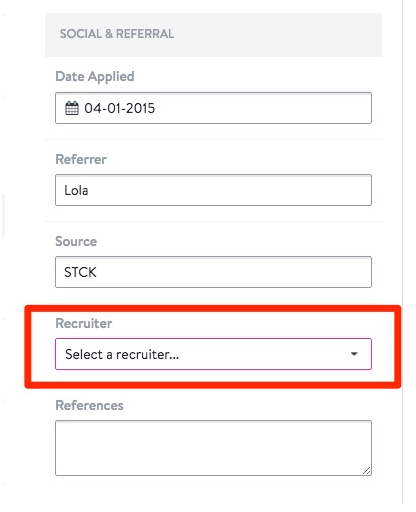
Key Features of JazzHR Collaboration Tools:
- Team Feedback and Evaluation:
JazzHR allows hiring teams to leave feedback on candidates directly within the platform. Recruiters and hiring managers can add notes, rate candidates, and track evaluations in one central location. The platform also offers customizable evaluation forms, which can be tailored to match the company’s hiring criteria. These forms ensure that team members provide consistent and structured feedback, reducing the risk of subjective evaluations. - Internal Messaging and Notes:
JazzHR includes internal messaging features that allow team members to communicate within the platform. Recruiters can leave private notes on candidate profiles, ensuring that important details are documented and easily accessible to the entire hiring team. However, JazzHR’s internal messaging tools are relatively basic. The platform lacks real-time chat functionality, which can make communication less immediate compared to more advanced collaboration tools offered by Workable. - User Roles and Permissions:
JazzHR provides role-based permissions, allowing administrators to control what information each team member can access. This feature is particularly useful for ensuring that sensitive candidate data is only visible to authorized users.
Workable Collaboration Tools
Workable’s collaboration tools are more comprehensive, making it an excellent choice for larger organizations or teams that require advanced communication features and more structured collaboration.
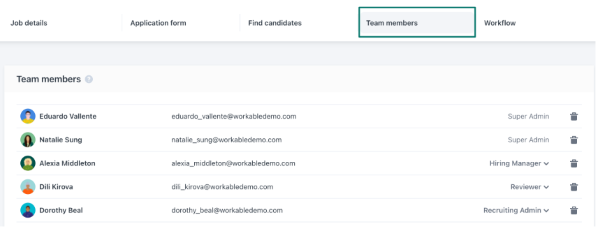
Key Features of Workable Collaboration Tools:
- Team Feedback and Evaluation:
Workable provides collaborative evaluation tools that allow team members to rate and review candidates directly within the platform. The platform supports structured scorecards, which standardize the evaluation process and ensure that feedback is collected consistently across all interviewers. Workable also offers automated reminders to ensure that team members provide feedback promptly, helping to speed up the decision-making process. - Internal Messaging and Notes:
One of Workable’s standout features is its real-time internal chat, which allows hiring teams to communicate instantly within the platform. This feature is particularly useful for coordinating interviews, discussing candidates, and making quick hiring decisions. In addition to real-time chat, Workable allows users to leave detailed notes on candidate profiles. All communication is centralized, ensuring that team members can easily access relevant information at any time. - User Roles and Permissions:
Workable offers granular user permissions, allowing administrators to customize access levels for each team member. This ensures that sensitive information is protected while giving team members the access they need to perform their roles effectively. - Hiring Team Collaboration:
Workable also provides tools for creating hiring teams for each job opening. This feature allows companies to assign specific roles and responsibilities to team members involved in the hiring process. Hiring teams can easily share feedback, track progress, and stay aligned on hiring decisions. This structured approach is particularly useful for organizations that involve multiple stakeholders in the recruitment process.
Comparison and Conclusion
When comparing JazzHR vs Workable for Collaboration Tools, the key difference lies in the depth and sophistication of the collaboration features. While JazzHR provides essential tools for team feedback and internal communication, Workable offers more advanced options that are better suited for larger, more complex hiring teams.
In summary:
- JazzHR is best for small to mid-sized businesses that need simple collaboration tools. Its evaluation forms, internal messaging, and role-based permissions are easy to use and provide the core functionality needed to keep hiring teams aligned.
- Workable is better for larger organizations or teams with complex hiring workflows. Its real-time internal chat, structured scorecards, and granular user permissions provide more advanced collaboration features, improving overall efficiency and decision-making.
Ultimately, the choice between JazzHR vs Workable for collaboration tools depends on your organization’s size and the complexity of your hiring process. JazzHR’s straightforward tools are ideal for smaller teams, while Workable’s more advanced features offer greater flexibility and efficiency for larger organizations.
Onboarding Integration
When comparing JazzHR vs Workable, both platforms provide tools to streamline the transition from hiring to onboarding. While neither is a full-fledged onboarding system, they integrate with popular Human Resource Information Systems (HRIS) and onboarding platforms to help recruiters manage offer letters, automate new hire paperwork, and ensure a smooth start for new employees. The level of integration and automation differs, making one platform more suitable depending on your organization’s needs.
JazzHR Onboarding Integration
JazzHR focuses on simplifying the offer letter process and automating initial onboarding tasks. Its integrations with third-party onboarding tools make it a practical solution for small to mid-sized businesses looking to reduce manual work during the onboarding process.
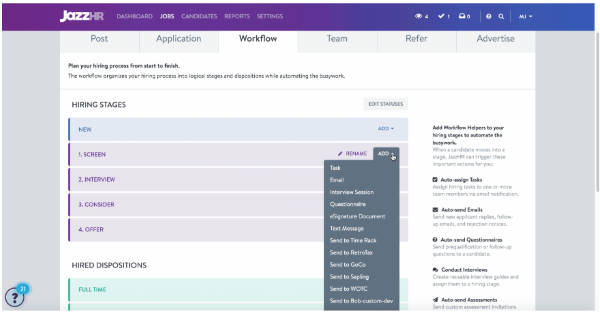
Key Features of JazzHR Onboarding Integration:
- Offer Letter Management:
JazzHR includes a built-in offer letter management tool that allows recruiters to create, customize, and send offer letters directly from the platform. Templates can be customized to include job-specific details, company branding, and legal language. Candidates can electronically sign offer letters, speeding up the acceptance process and reducing paperwork. JazzHR tracks the status of offer letters, ensuring that hiring teams can see when an offer is sent, viewed, and accepted. - New Hire Paperwork Automation:
While JazzHR does not have a native onboarding module, it integrates with popular HRIS and onboarding platforms, such as BambooHR, Sapling, and Zenefits. These integrations allow businesses to automate new hire paperwork, including tax forms, contracts, and employee handbooks. This integration makes it easy for businesses to move candidates from the hiring stage into the onboarding process without duplicating data entry. However, companies may need to rely on their HRIS for more advanced onboarding workflows. - Compliance and Document Tracking:
JazzHR helps ensure compliance by offering tools to track and manage important documents. The platform stores offer letters and other candidate documentation securely, reducing the risk of lost paperwork and ensuring that all hiring records are accessible in one place.
Workable Onboarding Integration
Workable takes a more robust approach to onboarding integration, focusing on automation and seamless data transfer between the hiring process and HR systems. The platform offers more built-in tools to handle the early stages of onboarding and integrates with leading HRIS platforms to support a comprehensive onboarding process.
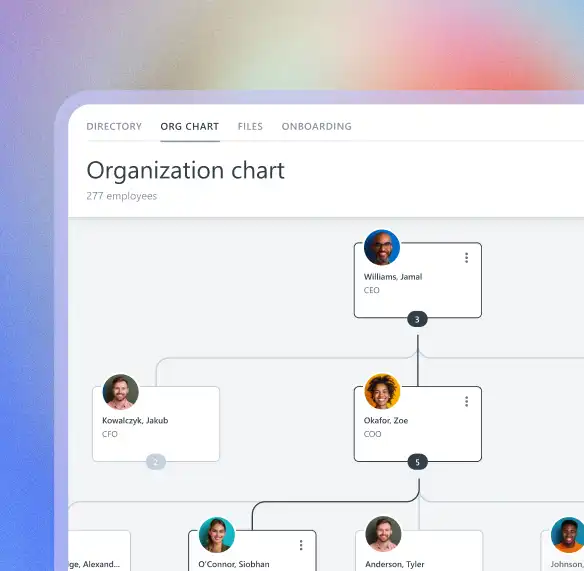
Key Features of Workable Onboarding Integration:
- Offer Letter Management:
Workable includes a customizable offer letter tool that allows recruiters to generate, send, and track offer letters. The platform supports e-signatures, ensuring that new hires can quickly accept offers from any device. Workable’s offer letter feature integrates with the platform’s candidate profile, making it easy to manage all hiring-related documents in one place. The system also provides reminders to follow up on pending offer letters, helping recruiters stay on top of the process. - New Hire Paperwork Automation:
Workable offers automated document requests for new hires, allowing recruiters to send required forms directly through the platform. New hires can complete and submit forms electronically, reducing the administrative burden on HR teams. Additionally, Workable integrates with several HRIS platforms, such as Bob, BambooHR, and Namely, to ensure that all candidate information is transferred seamlessly into the company’s HR system. This integration eliminates manual data entry and reduces the risk of errors. - Pre-Onboarding Tasks:
Workable includes tools to manage pre-onboarding tasks, such as background checks, reference checks, and IT setup requests. These tasks can be assigned to specific team members and tracked within the platform, ensuring that everything is ready before the new hire’s start date. - Employee Self-Service Portal:
Workable offers a self-service portal for new hires, where they can complete paperwork, access welcome materials, and learn more about the company before their first day. This feature helps create a more engaging and organized onboarding experience for new employees.
Comparison and Conclusion
When comparing JazzHR vs Workable for Onboarding Integration, the key difference lies in the level of automation and built-in tools each platform offers. While JazzHR provides essential onboarding tools and integrations, Workable takes a more comprehensive approach by offering more advanced features and seamless pre-onboarding workflows.
In summary:
- JazzHR is best suited for small to mid-sized businesses that need basic offer letter management and integration with third-party onboarding tools. Its simple document tracking and compliance features help streamline the transition from hiring to onboarding.
- Workable is better for larger organizations or teams that require a more comprehensive onboarding solution. Its built-in pre-onboarding tools, self-service portal, and seamless HRIS integrations help ensure a smooth and automated onboarding process.
Ultimately, the decision between JazzHR vs Workable for onboarding integration depends on your organization’s size and onboarding requirements. JazzHR provides a solid solution for businesses looking to simplify the transition from hiring to onboarding, while Workable offers more advanced tools for companies seeking a fully automated and seamless onboarding process.
Reporting and Analytics
Robust reporting and analytics features are essential for tracking recruitment performance, identifying bottlenecks, and improving hiring strategies. When comparing JazzHR vs Workable, both platforms offer reporting tools to help recruiters monitor key metrics, but they differ in terms of customization options, data visualization, and depth of insights.
JazzHR Reporting and Analytics
JazzHR provides essential reporting tools that are easy to use and designed for small to mid-sized businesses. The platform focuses on offering pre-built reports that cover the most critical recruitment metrics, making it accessible for teams without extensive data analysis experience.
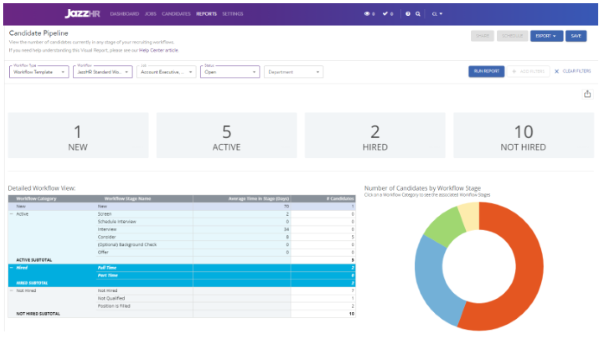
Key Features of JazzHR Reporting and Analytics:
- Recruitment Metrics and KPIs:
JazzHR offers a range of pre-built reports that track essential recruitment metrics such as time-to-hire, source effectiveness, and candidate pipeline activity. These reports help recruiters identify where candidates are coming from, how long it takes to fill positions, and which stages of the hiring process may need improvement. The platform also provides insights into candidate drop-off rates, helping teams optimize their hiring workflows to reduce friction and improve the overall candidate experience. - Custom Report Generation:
While JazzHR offers pre-built reports, it also allows users to create custom reports based on specific hiring needs. Recruiters can filter data by job postings, hiring stages, or time periods to get more granular insights. However, JazzHR’s reporting customization is relatively basic compared to Workable. While it covers the most common use cases, more advanced users may find it limiting when trying to generate highly specific reports. - Dashboard and Data Visualization:
JazzHR includes a dashboard that provides a quick snapshot of key recruitment metrics. The dashboard is easy to navigate and provides visual summaries of candidate pipelines, job performance, and recruiter activity. While the dashboard is functional, it may lack the advanced data visualization options offered by Workable, making it more suited for smaller teams with straightforward reporting needs.
Workable Reporting and Analytics
Workable takes a more advanced approach to reporting and analytics, offering deeper insights and more customizable reporting options. The platform is designed to help larger organizations track performance across multiple locations, departments, and job functions, making it ideal for complex hiring workflows.
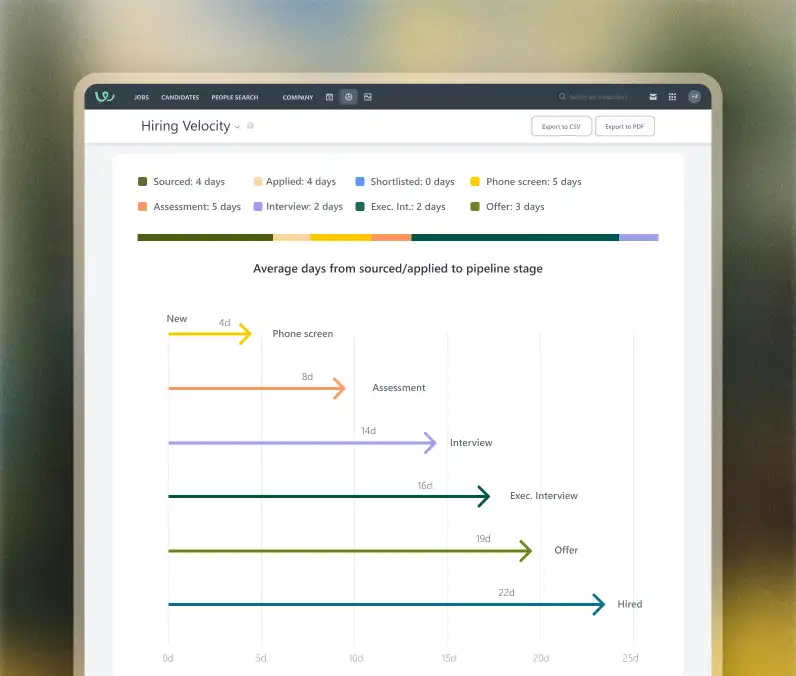
Key Features of Workable Reporting and Analytics:
- Recruitment Metrics and KPIs:
Workable provides detailed performance metrics that go beyond basic reports. The platform tracks key indicators such as time-to-fill, cost-per-hire, and candidate conversion rates, allowing recruiters to identify inefficiencies in their processes and adjust strategies accordingly. Workable’s reports also include sourcing analytics, helping recruiters determine which job boards and channels are delivering the best results. These insights help optimize recruitment budgets and improve the quality of incoming candidates. - Custom Report Generation:
One of Workable’s standout features is its custom report builder, which allows users to create highly customized reports tailored to their specific needs. Users can filter data by job type, department, recruiter performance, and other variables to gain actionable insights. Workable also supports scheduled reports, which can be automatically generated and sent to key stakeholders on a regular basis, ensuring that hiring teams stay informed without manual intervention. - Dashboard and Data Visualization:
Workable’s real-time dashboard provides a comprehensive view of the hiring process, including live updates on candidate progress, job performance, and team activity. The platform offers data visualization tools, such as charts and graphs, to make it easier for recruiters to interpret key data points and share insights with stakeholders. The dashboard can be customized to display the most relevant metrics for each user, ensuring that recruiters, hiring managers, and executives can quickly access the data that matters most to them.
Comparison and Conclusion
When comparing JazzHR vs Workable for Reporting and Analytics, the primary difference lies in the level of customization and depth of insights. JazzHR provides essential reporting tools that are easy to use and sufficient for smaller teams, while Workable offers more advanced features for larger organizations that require deeper analysis and more complex reporting capabilities.
In summary:
- JazzHR is ideal for small to mid-sized businesses that need straightforward reporting tools. Its pre-built reports and customizable filters provide valuable insights without overwhelming users with too many options.
- Workable is better suited for larger organizations or recruitment agencies that require advanced analytics and custom reporting. Its real-time dashboard, data visualization tools, and scheduled reports help hiring teams track performance and make data-driven decisions.
Ultimately, the choice between JazzHR vs Workable for reporting and analytics depends on the level of insight your organization needs. JazzHR offers a practical solution for businesses looking to track basic hiring metrics, while Workable provides more advanced tools for companies that want deeper insights and greater reporting flexibility.
Compliance and Data Security
Compliance and data security are critical considerations when choosing an applicant tracking system (ATS), especially for companies that handle sensitive candidate information. When comparing JazzHR vs Workable, both platforms provide essential compliance features to help businesses adhere to data privacy regulations and protect sensitive data. However, there are differences in their approaches to data security measures and regulatory compliance.
JazzHR Compliance and Data Security
JazzHR offers tools to help companies stay compliant with data privacy laws such as GDPR (General Data Protection Regulation) and EEOC (Equal Employment Opportunity Commission) requirements. The platform focuses on secure data storage, access control, and basic compliance features to ensure that businesses manage candidate data responsibly.

Key Features of JazzHR Compliance and Data Security:
- GDPR and Data Privacy Compliance:
JazzHR provides built-in features to help companies comply with GDPR requirements. The platform offers tools for obtaining candidate consent and managing data retention policies. Recruiters can configure automatic data deletion rules to ensure that candidate information is not kept longer than necessary. The system also provides candidates with the ability to request data deletion, helping businesses adhere to GDPR’s “right to be forgotten” requirement. These features are essential for European companies or any business that recruits candidates from the EU. - Secure Data Storage and Access Control:
JazzHR ensures that candidate data is stored securely with encryption measures in place to protect information both at rest and in transit. The platform also offers role-based access controls, allowing administrators to manage who can view and edit sensitive candidate information. This helps reduce the risk of data breaches by ensuring that only authorized personnel have access to specific data. JazzHR also includes audit logs to track user activity within the system, providing visibility into who accessed or modified data. - Compliance Reporting:
JazzHR provides compliance reporting tools that allow companies to generate reports for audits or internal reviews. These reports can help businesses demonstrate compliance with data privacy regulations and ensure that hiring practices are fair and consistent.
Workable Compliance and Data Security
Workable takes a more comprehensive approach to compliance and data security, offering advanced features to help businesses adhere to global data privacy regulations and protect sensitive candidate information. The platform is designed to support multi-regional compliance, making it suitable for organizations that hire across different countries and jurisdictions.
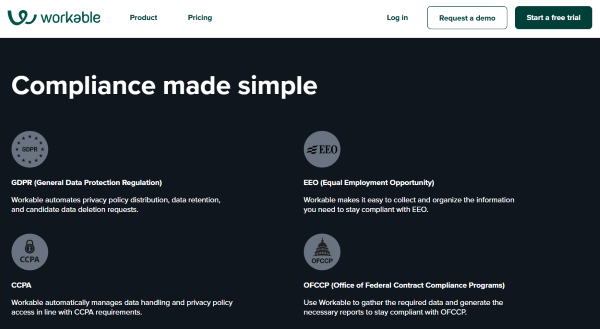
Key Features of Workable Compliance and Data Security:
- GDPR, CCPA, and Global Compliance:
Workable provides robust tools to ensure compliance with GDPR, CCPA (California Consumer Privacy Act), and other global data privacy laws. The platform offers customizable consent forms that can be tailored to meet local regulatory requirements, ensuring that companies collect and store candidate data responsibly. Workable also supports data access requests, allowing candidates to request copies of their personal data or ask for it to be deleted, which is crucial for GDPR and CCPA compliance. - Data Encryption and Security Measures:
Workable prioritizes data security with enterprise-grade encryption for data at rest and in transit. The platform also includes multi-factor authentication (MFA) to provide an additional layer of security for user accounts. In addition to encryption and MFA, Workable offers IP whitelisting, allowing companies to restrict access to their ATS based on specific IP addresses. This feature is particularly useful for organizations with strict security policies that want to limit access to trusted networks only. - Advanced Access Controls and Audit Logs:
Workable provides granular access controls, allowing companies to customize user permissions based on specific roles. This ensures that sensitive data is only accessible to those who need it. The platform also offers detailed audit logs, which track all user actions within the system. This feature is critical for compliance audits and can help organizations identify suspicious activity or unauthorized access attempts. - Compliance Certifications:
Workable holds ISO 27001 certification, an internationally recognized standard for information security management. This certification demonstrates that the platform follows best practices for managing sensitive data and mitigating security risks.
Comparison and Conclusion
When comparing JazzHR vs Workable for Compliance and Data Security, both platforms provide essential tools to help businesses protect candidate data and meet regulatory requirements. However, Workable offers more advanced security measures and supports a wider range of compliance needs, making it a better choice for larger organizations or businesses with complex security requirements.
In summary:
- JazzHR is ideal for small to mid-sized businesses that need basic compliance features to manage GDPR requirements and secure candidate data. Its role-based access controls and compliance reporting tools are easy to use and sufficient for most small teams.
- Workable is better suited for larger organizations or companies hiring across multiple regions. Its advanced security measures, multi-regional compliance support, and ISO 27001 certification provide peace of mind for businesses handling large volumes of sensitive data.
Ultimately, the choice between JazzHR vs Workable for compliance and data security depends on your organization’s size and regulatory requirements. JazzHR offers practical tools for smaller teams, while Workable provides more comprehensive solutions for businesses needing higher security standards and multi-regional compliance support.
Integration and Compatibility
When evaluating JazzHR vs Workable, it’s essential to consider how well each platform integrates with other tools and systems in your HR tech stack. Both ATS platforms offer integrations with popular third-party tools, including HRIS systems, job boards, background check providers, and communication tools. However, the level of compatibility and ease of integration can vary depending on your organization’s specific needs.
JazzHR Integration and Compatibility
JazzHR is designed to work seamlessly with a wide range of third-party tools, making it a practical choice for small to mid-sized businesses that need a flexible ATS. The platform prioritizes integrations that enhance the hiring process, from job posting and candidate screening to onboarding and compliance.
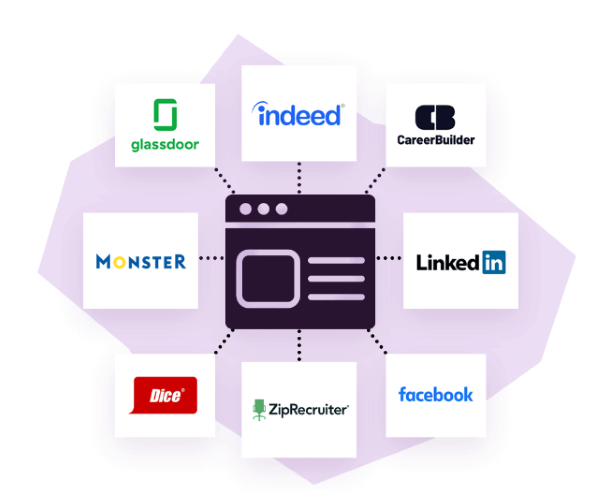
Key Features of JazzHR Integration and Compatibility:
- HRIS/HCM System Integration:
JazzHR integrates with several popular HRIS (Human Resource Information Systems) and HCM (Human Capital Management) platforms, such as BambooHR, Gusto, and Zenefits. These integrations help businesses streamline the transition from hiring to onboarding by automatically syncing candidate data with their HR systems. This reduces manual data entry and ensures that new hire information is accurately recorded across systems, improving efficiency and reducing errors. - Third-Party Tool Integrations:
JazzHR offers native integrations with a variety of third-party tools that support key recruitment functions, including background checks, assessment tools, and video interview platforms. Some of the commonly used integrations include Checkr for background screening, Spark Hire for video interviews, and Wonscore by Wonderlic for candidate assessments. Additionally, JazzHR integrates with popular email and calendar tools such as Gmail, Outlook, and Google Calendar, making it easy to schedule interviews and communicate with candidates directly from the platform. - Job Board Integrations:
JazzHR provides one-click job posting to a wide range of job boards, including Indeed, LinkedIn, Glassdoor, and ZipRecruiter. The platform also offers premium job board integrations, which allow companies to promote their job openings on specialized or paid job boards for broader visibility. However, JazzHR’s integrations may require more manual configuration compared to Workable, especially for businesses with complex workflows. - API and Custom Integrations:
JazzHR offers an open API, allowing businesses to create custom integrations with their existing tools or proprietary systems. This flexibility is useful for companies that have unique needs or want to build a more tailored recruitment workflow.
Workable Integration and Compatibility
Workable is known for its plug-and-play integration capabilities, making it a great choice for larger organizations or those with complex hiring processes. The platform offers a wide range of integrations, covering everything from job boards and HRIS systems to communication tools and sourcing platforms.
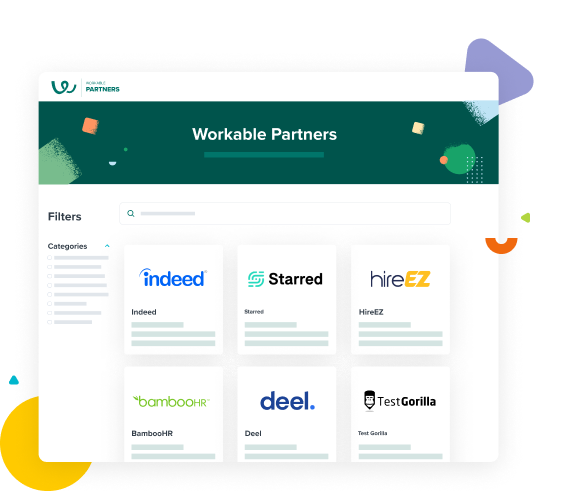
Key Features of Workable Integration and Compatibility:
- HRIS/HCM System Integration:
Workable integrates with a variety of HRIS and HCM systems, including Bob, Namely, and BambooHR. These integrations help streamline the hiring process by automatically transferring candidate information to the company’s HR system once a candidate is hired. Workable’s HRIS integrations are particularly useful for larger organizations that need to manage employee data across multiple locations or departments. - Third-Party Tool Integrations:
Workable offers a wide range of third-party integrations, including tools for background checks, candidate assessments, video interviews, and e-signatures. Popular integrations include Checkr for background checks, Codility for technical assessments, and Zoom for virtual interviews. The platform also integrates with Slack, enabling real-time notifications and updates within the hiring team’s communication channels. This helps improve collaboration and ensures that everyone stays informed throughout the recruitment process. - Job Board Integrations:
Workable provides one-click job posting to over 200 job boards globally, including LinkedIn, Indeed, Monster, and Facebook Jobs. The platform’s extensive job board network helps businesses reach a larger pool of candidates, including niche and regional job boards. Workable also offers AI-powered sourcing tools that help recruiters find passive candidates by scanning public profiles on the web and importing them directly into the platform. - API and Custom Integrations:
Workable offers an open API for businesses that need custom integrations. The API allows companies to connect Workable with their proprietary systems or build custom workflows to suit their unique hiring needs. Workable’s Zapier integration is another highlight, enabling users to connect the platform with thousands of other tools without needing extensive coding knowledge. This makes it easy to automate tasks and improve overall efficiency.
Comparison and Conclusion
When comparing JazzHR vs Workable for Integration and Compatibility, the key difference lies in the depth and ease of integrations. While both platforms offer a wide range of third-party integrations and open API access, Workable provides more out-of-the-box integrations and plug-and-play capabilities, making it a better fit for larger organizations with complex recruitment needs.
In summary:
- JazzHR is best suited for small to mid-sized businesses that need flexible integrations with HRIS systems, job boards, and third-party tools. Its open API offers customization options, but some integrations may require more manual configuration.
- Workable is better for larger organizations or companies handling high-volume hiring. Its extensive integration options, plug-and-play capabilities, and AI-powered sourcing tools make it a comprehensive solution for teams looking to streamline their recruitment workflows.
Ultimately, the choice between JazzHR vs Workable for integration and compatibility depends on your organization’s tech stack and hiring needs. JazzHR offers essential integrations for small to mid-sized businesses, while Workable provides more advanced compatibility for larger, more complex hiring processes.
Customization and Scalability
When comparing JazzHR vs Workable, it’s essential to consider how well each platform can be tailored to meet the unique needs of your organization. Customization ensures that an ATS adapts to your specific hiring workflows, while scalability ensures that the platform can grow with your business as your recruitment needs evolve. Both JazzHR and Workable offer varying degrees of customization and scalability, but their approaches differ significantly.
JazzHR Customization and Scalability
JazzHR is designed with simplicity and flexibility in mind, making it a practical choice for small to mid-sized businesses. The platform offers customizable workflows, templates, and user permissions, allowing companies to tailor the system to fit their unique recruitment processes.
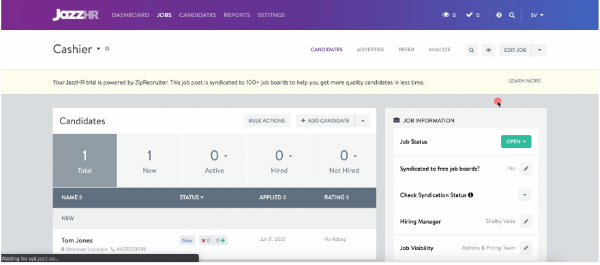
Key Features of JazzHR Customization and Scalability:
- Workflow Customization:
JazzHR allows users to customize hiring workflows to match their existing processes. Recruiters can create custom pipeline stages, configure automated actions for each stage, and set rules for moving candidates through the hiring process. For example, companies can create workflows specific to different job types or departments, ensuring that each hiring process aligns with the organization’s internal requirements. - Branded Career Sites and Templates:
JazzHR offers career site customization tools, allowing companies to build branded career pages that reflect their employer brand. Users can modify the layout, colors, and content of the career site to create a consistent brand experience for candidates. Additionally, recruiters can create custom email templates for communication with candidates, ensuring that messaging remains consistent and professional throughout the hiring process. - User Roles and Permissions:
JazzHR includes role-based access controls, enabling administrators to assign specific permissions to users based on their roles. This ensures that sensitive information is only accessible to authorized team members and that each user can access the features they need without being overwhelmed by unnecessary options. - Scalability for Growing Businesses:
JazzHR is designed to scale with growing businesses. While it may not offer the same enterprise-level features as Workable, it is capable of handling high-volume hiring for companies expanding their workforce. However, JazzHR’s scalability may be limited for very large organizations with complex recruitment needs or multiple locations. The platform is best suited for companies that need a balance between flexibility and ease of use.
Workable Customization and Scalability
Workable is a more robust platform designed to support high-volume hiring and large, distributed teams. It offers extensive customization options, allowing organizations to tailor workflows, reporting, and user access to fit their specific needs. Workable’s scalability makes it a great fit for businesses that expect their recruitment needs to grow over time.
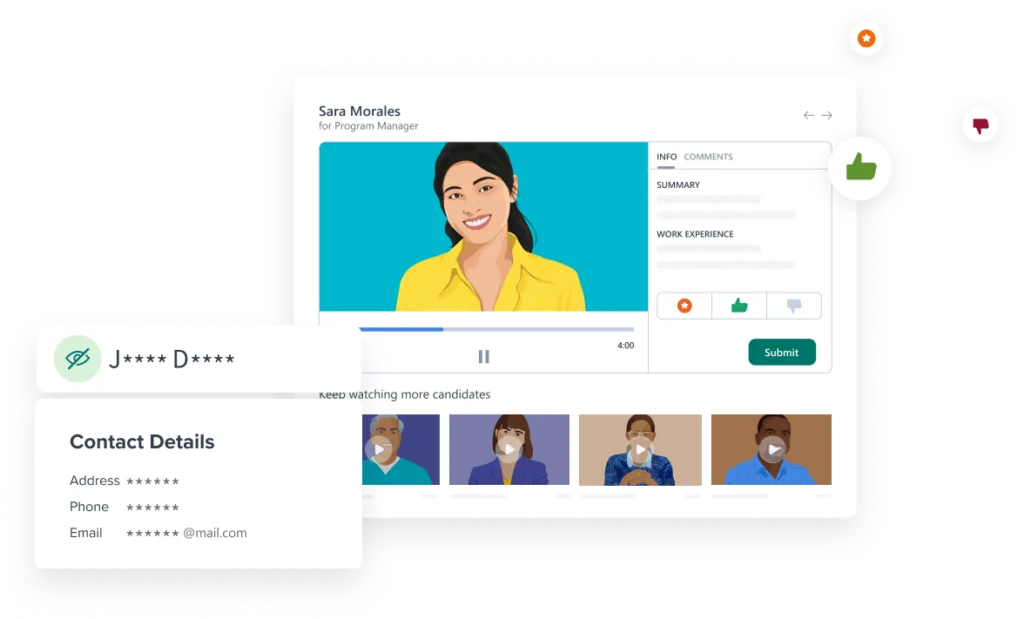
Key Features of Workable Customization and Scalability:
- Advanced Workflow Customization:
Workable provides highly customizable hiring workflows, allowing users to create unique workflows for different roles, departments, or locations. The platform supports conditional workflows, where different actions can be triggered based on candidate progress, making it a flexible solution for complex recruitment processes. Recruiters can also set automated actions at each stage of the hiring process, such as sending follow-up emails or triggering background checks. - Branded Career Pages and Communication:
Workable offers more advanced career site customization than JazzHR. Users can build mobile-optimized, multilingual career pages that reflect their brand and provide a seamless experience for candidates. Workable also supports custom communication templates, ensuring that messaging remains personalized and consistent. The platform allows for automated email sequences, helping recruiters stay engaged with candidates throughout the hiring process. - User Roles and Granular Permissions:
Workable includes granular user permissions, allowing administrators to customize access levels based on user roles. This feature is particularly valuable for large organizations with multiple hiring teams, as it ensures that users only see the information relevant to their tasks. Additionally, Workable allows for team-based collaboration, where different teams can work on specific job openings without interfering with each other’s processes. - Enterprise-Level Scalability:
Workable is built to scale with enterprise-level hiring needs. The platform can handle high-volume recruiting across multiple locations and departments, making it an ideal choice for larger organizations or companies experiencing rapid growth. Workable’s scalability is further supported by its AI-powered tools and automation features, which help reduce the workload for recruiters as hiring needs increase.
Comparison and Conclusion
When comparing JazzHR vs Workable for Customization and Scalability, the primary difference lies in the depth of customization options and the ability to handle large-scale recruitment. JazzHR offers essential customization tools that work well for small to mid-sized businesses, while Workable provides more advanced options for larger organizations with complex needs.
In summary:
- JazzHR is best suited for small to mid-sized businesses that need a flexible, easy-to-customize platform. Its customizable workflows, career sites, and user permissions are practical for growing companies that want a straightforward solution.
- Workable is ideal for larger organizations or companies with complex recruitment needs. Its advanced customization options, granular user permissions, and enterprise-level scalability make it a powerful solution for high-volume hiring and multi-location recruitment.
Ultimately, the decision between JazzHR vs Workable for customization and scalability depends on your organization’s size and hiring complexity. JazzHR provides a flexible solution for growing businesses, while Workable is better suited for enterprises needing advanced customization and scalability to handle complex recruitment workflows.
AI and Automation Features
The use of AI and automation in applicant tracking systems (ATS) can significantly improve hiring efficiency by reducing manual tasks and helping recruiters focus on more strategic activities. When comparing JazzHR vs Workable, both platforms offer AI and automation features to streamline recruitment, but Workable provides more advanced AI-powered tools to enhance sourcing, screening, and candidate engagement.
JazzHR AI and Automation Features
JazzHR focuses on simplifying and automating routine recruitment tasks to help small to mid-sized businesses save time and improve efficiency. While it doesn’t offer advanced AI features like Workable, it includes practical automation tools to reduce administrative work and improve candidate management.
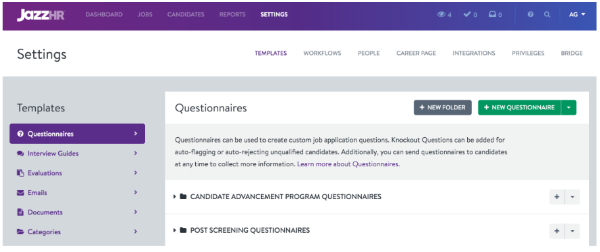
Key Features of JazzHR AI and Automation:
- Automated Job Posting:
JazzHR allows recruiters to automate job posting to multiple job boards with a single click. The platform integrates with major job boards like Indeed, LinkedIn, and Glassdoor, ensuring that job openings reach a wide audience without requiring manual posting to each site. - Automated Screening and Disqualification:
JazzHR includes a customizable screening tool that automatically filters candidates based on predefined criteria. Recruiters can set up screening questions for each job posting, and the system will automatically disqualify candidates who don’t meet the minimum requirements. This feature helps reduce the time spent reviewing unqualified applications, allowing recruiters to focus on top candidates. - Email Automation:
JazzHR offers automated email templates that help recruiters communicate with candidates throughout the hiring process. The platform can automatically send follow-up emails, rejection letters, and interview invitations, ensuring that candidates are kept informed without manual intervention. - Workflow Automation:
JazzHR allows users to automate parts of their hiring workflow. For example, recruiters can set up triggers to move candidates to the next stage in the hiring process once certain criteria are met, such as completing a screening questionnaire or passing a background check.
While JazzHR’s automation features are practical and easy to use, they may feel limited for companies looking for more advanced AI capabilities, such as candidate matching and predictive analytics.
Workable AI and Automation Features
Workable offers a more sophisticated set of AI-powered tools and automation features designed to improve candidate sourcing, screening, and engagement. The platform’s focus on automation makes it a strong choice for organizations that handle high-volume hiring or need to optimize their recruitment processes.
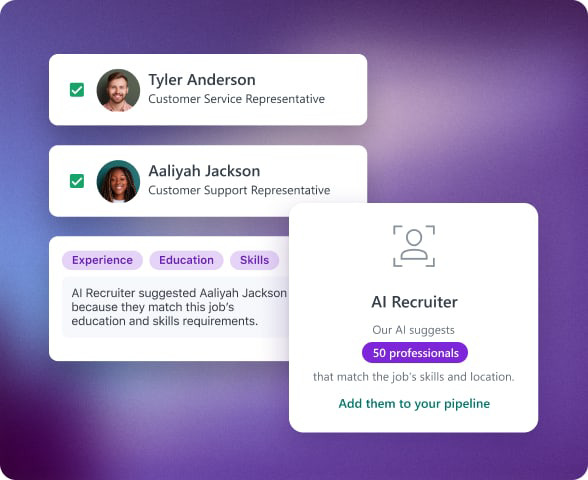
Key Features of Workable AI and Automation:
- AI-Powered Candidate Sourcing:
One of Workable’s standout features is its AI-powered sourcing tool, which helps recruiters find passive candidates by searching public profiles and social networks. The system uses machine learning algorithms to identify candidates who match the job requirements and automatically imports their profiles into the ATS. This feature is particularly useful for filling hard-to-fill roles, as it expands the talent pool beyond active job seekers. - Automated Candidate Matching:
Workable uses AI-driven candidate matching to rank applicants based on their suitability for the role. The platform analyzes resumes, job descriptions, and other data points to generate a match score, helping recruiters prioritize candidates who are most likely to be a good fit. This feature reduces the need for manual resume screening and ensures that recruiters spend more time engaging with top candidates. - Automated Screening and Assessments:
Workable’s automated screening tools allow recruiters to set up customizable screening questions and assessments that candidates must complete as part of their application. The system automatically scores the responses and disqualifies candidates who don’t meet the required criteria. Additionally, Workable integrates with assessment tools to automate technical and skill-based tests, providing more insights into a candidate’s suitability for the role. - Communication Automation:
Workable offers automated communication workflows, including personalized email sequences and SMS messages. The platform can automatically send updates, interview invitations, and follow-ups based on where a candidate is in the hiring process. - Workflow Automation and Task Management:
Workable includes workflow automation tools that help recruiters manage tasks more efficiently. The system can trigger automatic actions based on specific events, such as sending offer letters once a candidate reaches the final stage of the hiring process or scheduling interviews when candidates complete assessments. The platform also includes reminders and notifications to ensure that recruiters stay on top of important tasks and deadlines.
Comparison and Conclusion
When comparing JazzHR vs Workable for AI and Automation Features, the primary difference lies in the level of sophistication and AI-driven capabilities. JazzHR offers essential automation tools that help streamline the hiring process for small to mid-sized businesses, while Workable provides more advanced AI-powered features that enhance sourcing, screening, and engagement.
In summary:
- JazzHR is best suited for small to mid-sized businesses that need basic automation tools to reduce administrative work. Its automated job posting, screening, and email workflows help streamline the hiring process without overwhelming users with complex features.
- Workable is better for larger organizations or teams handling high-volume recruiting. Its AI-powered sourcing, candidate matching, and advanced automation tools help recruiters find and engage top talent more efficiently.
Ultimately, the decision between JazzHR vs Workable for AI and automation features depends on your organization’s size and hiring complexity. JazzHR provides practical automation for smaller teams, while Workable’s advanced AI tools offer more value for larger organizations seeking to optimize their recruitment workflows.
Candidate Experience
A positive candidate experience is crucial for attracting top talent and maintaining a strong employer brand. When comparing JazzHR vs Workable, both platforms offer tools to streamline the application process, improve communication, and keep candidates engaged throughout the hiring journey. However, their approaches differ in terms of personalization, automation, and ease of use.
JazzHR Candidate Experience
JazzHR focuses on simplifying the application process and making it easy for candidates to apply to jobs from any device. The platform prioritizes minimizing friction during the application process while providing recruiters with tools to communicate efficiently with candidates.
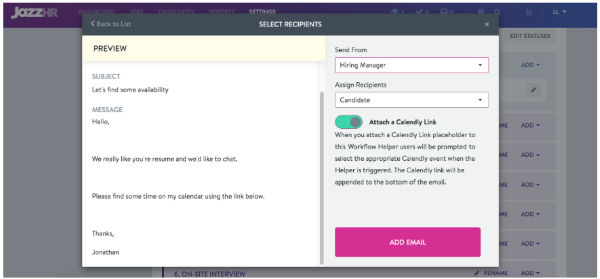
Key Features of JazzHR Candidate Experience:
- Application Process Simplicity:
JazzHR provides a mobile-responsive application process, ensuring that candidates can easily apply for jobs from any device. The platform supports one-click applications through integrations with job boards like Indeed and LinkedIn, reducing the time and effort required for candidates to submit their applications. Recruiters can also customize application forms and add screening questions, but JazzHR ensures that these questions are easy to navigate to avoid frustrating applicants. The system is designed to minimize candidate drop-off rates by keeping the application process short and straightforward. - Branded Career Sites:
JazzHR allows companies to build branded career sites that reflect their employer brand. These career pages can be customized with company logos, colors, and content to create a consistent experience for candidates. While JazzHR’s career site customization options are useful for smaller businesses, they may lack some of the advanced personalization features available in Workable. - Communication and Feedback Mechanisms:
JazzHR offers automated email templates to keep candidates informed throughout the hiring process. Recruiters can send status updates, interview invitations, and rejection letters with just a few clicks, ensuring candidates are not left in the dark. However, JazzHR’s communication tools primarily rely on email. The platform does not include built-in SMS communication or more personalized engagement options, which may be a drawback for recruiters who prefer to engage with candidates more dynamically. - Candidate Portal:
JazzHR provides a candidate portal where applicants can view their application status and manage their profile. This transparency helps improve the overall candidate experience by keeping applicants informed about their progress in the hiring process.
Workable Candidate Experience
Workable takes a more advanced approach to improving the candidate experience, offering tools for personalization, automated engagement, and mobile optimization. The platform is designed to create a seamless, engaging experience for candidates from application to onboarding.
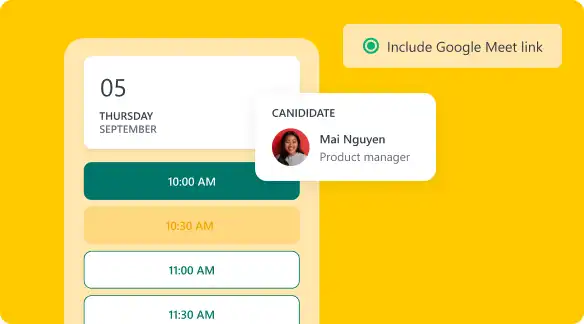
Key Features of Workable Candidate Experience:
- Application Process Simplicity:
Workable’s application process is mobile-friendly and optimized for speed. Candidates can apply through desktop, tablet, or mobile devices without any issues. The platform supports one-click applications through integrations with LinkedIn and other job boards, making it easy for candidates to submit their resumes quickly. Workable also allows companies to customize the application process with screening questions and assessment links. These customizations are designed to gather relevant information without overwhelming candidates, ensuring a smooth experience. - Personalized Career Pages:
Workable offers customizable career pages that provide a more engaging experience for candidates. Companies can add videos, photos, and custom content to showcase their culture and values, helping candidates get a better sense of what it’s like to work for the organization. Additionally, Workable’s career pages are multilingual, allowing companies to provide a localized experience for candidates in different regions. - Communication and Feedback Mechanisms:
Workable excels in candidate communication, offering built-in SMS messaging and automated email workflows. Recruiters can send personalized messages at various stages of the hiring process, ensuring that candidates feel engaged and informed. The platform also includes automated follow-ups and reminders, helping recruiters stay on top of communication without requiring manual effort. - Self-Service Candidate Portal:
Workable offers a self-service candidate portal, where applicants can view their progress, complete forms, and submit additional documents. This transparency helps improve the candidate experience by reducing uncertainty and keeping candidates informed throughout the process. - Candidate Feedback Collection:
Workable allows companies to collect feedback from candidates after the hiring process is complete. This feedback can be used to improve the recruitment experience and identify areas for improvement.
Comparison and Conclusion
When comparing JazzHR vs Workable for Candidate Experience, both platforms offer tools to improve the application process and keep candidates engaged. However, Workable provides more advanced personalization, communication options, and feedback mechanisms, making it a better choice for organizations looking to deliver a highly engaging experience.
In summary:
- JazzHR is best suited for small to mid-sized businesses that need a simple, mobile-friendly application process. The platform’s branded career sites and automated email workflows help improve the candidate experience without overwhelming recruiters with too many features.
- Workable is better for larger organizations or companies that prioritize personalization and engagement. Its advanced career page customization, built-in SMS messaging, and feedback collection tools provide a more dynamic and interactive candidate experience.
Ultimately, the choice between JazzHR vs Workable for candidate experience depends on your organization’s hiring goals. JazzHR offers a straightforward solution for companies focused on ease of use and basic engagement, while Workable provides more advanced tools for companies looking to create a highly personalized and engaging candidate journey.
Customer Support and Service
Reliable customer support is essential when selecting an applicant tracking system (ATS), as users need timely assistance to troubleshoot issues, implement the software effectively, and maximize its features. When comparing JazzHR vs Workable, both platforms provide customer support and training services, but they differ in availability, responsiveness, and the depth of their support offerings.
JazzHR Customer Support and Service
JazzHR is known for providing accessible and responsive customer support, making it a popular choice for small to mid-sized businesses that need assistance throughout the implementation process and beyond. The platform offers a variety of support channels to ensure users can get the help they need quickly.
Key Features of JazzHR Customer Support and Service:
- Dedicated Account Managers:
JazzHR assigns a dedicated account manager to each customer, providing personalized support and ensuring a smooth onboarding process. This level of attention is particularly beneficial for smaller businesses that may need more hands-on assistance during implementation. - Live Chat and Email Support:
JazzHR provides live chat support during business hours, allowing users to get immediate help with any issues they encounter. The platform also offers email support, ensuring that users can reach out with questions or concerns and receive a timely response. - Extensive Knowledge Base:
JazzHR offers an online knowledge base that includes articles, guides, and FAQs to help users resolve common issues independently. The knowledge base covers topics such as job posting, candidate management, and report generation, making it a valuable resource for self-service support. - Training and Onboarding Assistance:
JazzHR provides comprehensive onboarding assistance, including personalized training sessions to help users get familiar with the platform’s features. This training is especially useful for new users who want to quickly get up to speed with the system.
While JazzHR’s customer support is highly rated for its responsiveness and personalized approach, its support hours are primarily limited to business hours in the U.S., which may be a limitation for companies operating in different time zones.
Workable Customer Support and Service
Workable offers 24/7 customer support, making it a better option for larger organizations or companies with global operations that need assistance at any time. The platform is known for its proactive support approach, helping users optimize their use of the software through regular check-ins and personalized recommendations.
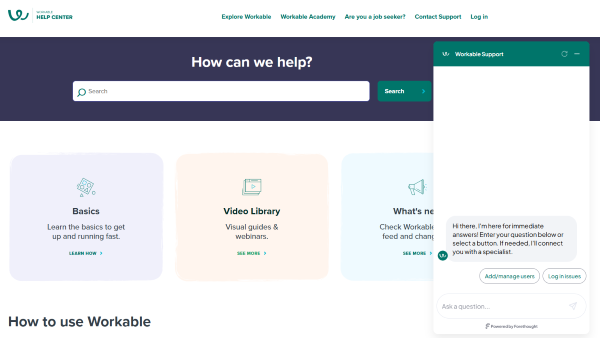
Key Features of Workable Customer Support and Service:
- 24/7 Support:
One of Workable’s standout features is its 24/7 customer support, available via live chat, phone, and email. This ensures that users can get assistance whenever they need it, regardless of their time zone or location. - Dedicated Customer Success Managers:
Workable assigns a Customer Success Manager (CSM) to help users with ongoing support and optimization. These CSMs provide personalized recommendations to help companies improve their hiring processes and get the most out of Workable’s features. - In-App Support:
Workable offers in-app support, allowing users to access help directly from the platform. This feature includes instant answers to FAQs and the ability to connect with support agents without leaving the ATS interface. - Onboarding and Training Programs:
Workable provides customized onboarding programs based on the size and needs of each company. These programs include detailed training sessions and step-by-step guidance to ensure users can effectively implement the system and optimize their recruitment workflows. - Knowledge Base and Community Resources:
Workable offers an extensive knowledge base and community forums, where users can find helpful resources, best practices, and advice from other Workable users. These self-service options help users troubleshoot issues and learn how to use new features.
Workable’s proactive support and round-the-clock availability make it a strong choice for larger organizations or businesses with complex hiring needs that require continuous assistance.
Comparison and Conclusion
When comparing JazzHR vs Workable for Customer Support and Service, the key differences lie in availability and support depth. JazzHR offers personalized support that is highly rated by users but is primarily limited to U.S. business hours. In contrast, Workable provides 24/7 support and a more proactive customer success program, making it better suited for larger organizations or companies with global operations.
In summary:
- JazzHR is best for small to mid-sized businesses that need responsive, personalized support during business hours. Its dedicated account managers and live chat support help ensure that users can get assistance when they need it most.
- Workable is ideal for larger organizations or global companies that require 24/7 support and ongoing customer success management. The platform’s round-the-clock availability and proactive approach help ensure that users get the most out of the system.
Ultimately, the decision between JazzHR vs Workable for customer support and service depends on your organization’s size and need for round-the-clock availability. JazzHR provides highly personalized support for smaller businesses, while Workable delivers continuous assistance and proactive optimization for larger companies with more complex hiring requirements.
Pricing and Cost-effectiveness
When comparing JazzHR vs Workable, pricing is a key factor for companies deciding which ATS best fits their budget and hiring needs. Both platforms offer different pricing models that cater to businesses of various sizes and hiring volumes. Understanding the cost structure, what features are included, and the overall return on investment (ROI) can help you determine which solution is more cost-effective for your organization.
JazzHR Pricing and Cost-effectiveness
JazzHR is known for its affordable and flexible pricing plans, making it a popular choice for small to mid-sized businesses. The platform offers three tiered plans based on the number of features and customization options, which allows companies to choose a package that best suits their hiring needs.
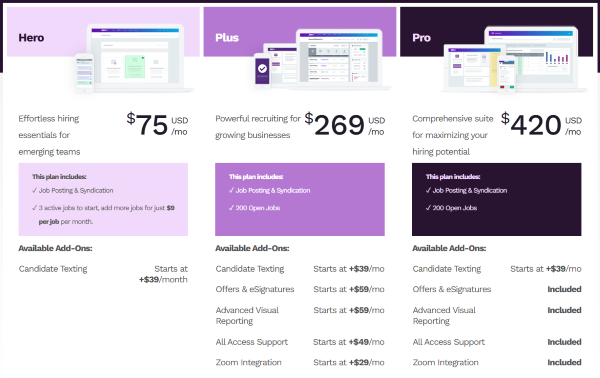
Key Features of JazzHR Pricing
JazzHR uses a flat-rate pricing model that is based on the features included in each plan rather than the number of users. This can be especially cost-effective for businesses with larger hiring teams, as they won’t have to pay for each additional user.
The pricing tiers are as follows:
- Hero Plan: Starting at around $39 per month, this plan includes basic job posting and applicant tracking features.
- Plus Plan: Priced at approximately $229 per month, this plan includes additional features such as offer letter management and custom reporting.
- Pro Plan: At around $339 per month, the Pro Plan offers advanced features like compliance tracking, integrations, and premium support.
All JazzHR plans include unlimited users, job posting to free job boards, and resume parsing. Higher-tier plans include additional features like custom workflows, e-signatures, and advanced reporting. JazzHR does not charge per job posting or per hire, which makes it an attractive option for companies that handle high-volume hiring without incurring additional costs.
JazzHR’s flat-rate pricing and unlimited user access make it a cost-effective solution for small to mid-sized businesses. The platform provides essential ATS features at a fraction of the cost of many enterprise-level systems, delivering a strong ROI for companies with limited budgets. However, it’s important to note that some features, such as premium job board postings, come at an additional cost, which could increase the overall expenses for companies relying heavily on paid job promotions.
For more information about pricing, se visit JazzHR’s website.
Workable Pricing and Cost-effectiveness
Workable offers a more comprehensive pricing model designed to accommodate businesses of all sizes, from small teams to large enterprises. The platform’s pricing is more feature-rich compared to JazzHR, but it also comes at a higher cost, especially for companies that need advanced AI tools and extensive integrations.
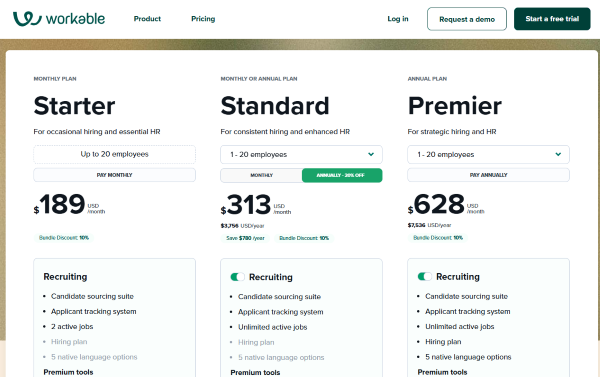
Key Features of Workable Pricing
Workable uses a per-job pricing model that charges based on the number of active job postings. This can be more cost-effective for companies with occasional hiring needs but may become expensive for organizations handling continuous high-volume hiring.
Workable’s pricing starts at $129 per job per month, with discounts available for companies with higher volumes or those that opt for annual plans. The platform also offers custom enterprise pricing for larger organizations with complex hiring needs.
Workable’s pricing includes access to its AI-powered sourcing tools, automated workflows, and comprehensive integrations. The platform also provides access to over 200 job boards, which is included in the subscription cost, reducing the need for additional job board spending. Higher-tier plans include features like candidate assessments, video interviews, and compliance tracking. These advanced tools provide added value for companies looking to optimize their hiring process.
Workable’s per-job pricing can be a cost-effective solution for smaller businesses with occasional hiring needs. However, companies with ongoing recruitment may find the costs add up quickly, making the platform more suitable for larger organizations that prioritize advanced tools and automation. The inclusion of AI-driven features, job board access, and sourcing tools in Workable’s pricing can offset some of the costs by reducing the need to pay for separate tools and job board fees.
For more information about pricing, se visit Workable’s website.
Comparison and Conclusion
When comparing JazzHR vs Workable for Pricing and Cost-effectiveness, the best choice depends on your hiring volume, team size, and need for advanced features. JazzHR’s flat-rate pricing is more predictable and affordable for small to mid-sized businesses, while Workable’s per-job pricing model provides access to more advanced tools but may be more expensive for companies with continuous hiring needs.
In summary
JazzHR is best for small to mid-sized businesses that want a predictable, flat-rate pricing model. It offers unlimited users and essential ATS features at a cost-effective rate, making it ideal for companies with fixed budgets. Workable is better suited for larger organizations or companies that want AI-powered tools and comprehensive integrations. While its per-job pricing can be more costly for high-volume hiring, it provides extensive features that can deliver value for companies with complex recruitment needs.
Ultimately, the choice between JazzHR vs Workable for Pricing and Cost-effectiveness comes down to your organization’s size and hiring volume. JazzHR offers an affordable solution for businesses looking to manage their hiring process on a budget, while Workable provides more advanced tools and automation that may be worth the investment for companies with complex hiring needs or global operations.
User Reviews and Testimonials
User reviews and testimonials provide valuable insights into how real users experience applicant tracking systems. When comparing JazzHR vs Workable, both platforms receive positive feedback for their ease of use, functionality, and customer support. However, their user bases and typical customer feedback highlight differences in how each system performs for different types of organizations.
JazzHR User Reviews and Testimonials
JazzHR is often praised by small to mid-sized businesses for its user-friendly interface, affordable pricing, and responsive customer support. Many users appreciate the platform’s straightforward features that simplify job posting, candidate tracking, and communication without unnecessary complexity.
Key Insights from JazzHR User Reviews
- Ease of Use:
One of the most common praises for JazzHR is its intuitive design. Users frequently mention that the platform is easy to set up and requires minimal training to get started. This makes JazzHR a popular choice for businesses that need a fast, efficient way to streamline their hiring process. Many users highlight how the system reduces time-to-hire by making it easy to manage candidate pipelines, send offer letters, and automate routine tasks. - Customer Support:
JazzHR’s dedicated account managers and live chat support receive positive feedback from users who value personalized assistance. Businesses appreciate the quick response times and hands-on support during implementation and day-to-day use. Users also praise the knowledge base and training resources, which help them resolve issues independently. - Cost-effectiveness:
Many reviewers mention that JazzHR delivers excellent value for money, particularly for smaller businesses with limited budgets. The flat-rate pricing model and unlimited user access are frequently cited as reasons why JazzHR is a cost-effective solution for teams that need essential ATS features without paying for additional tools they don’t use.
Common Criticisms of JazzHR
Some users feel that JazzHR’s customization options are limited compared to more advanced platforms. Others mention that the reporting tools could be more robust, especially for companies that need detailed analytics to track their hiring performance.
Overall, JazzHR is well-reviewed for its simplicity, affordability, and customer support, making it a great choice for small to mid-sized businesses.
Workable User Reviews and Testimonials
Workable is widely regarded as a comprehensive recruitment solution that caters to larger organizations and high-volume hiring needs. Users appreciate the platform’s advanced features, such as AI-powered candidate sourcing, customizable workflows, and seamless integrations.
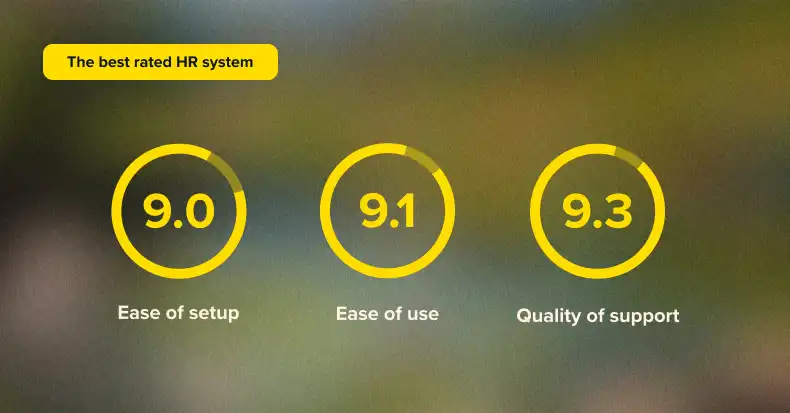
Key Insights from Workable User Reviews
- Advanced Features:
Workable receives praise for its robust feature set, particularly its AI-powered tools that help recruiters find passive candidates and match applicants to open roles. Users highlight how these features reduce manual tasks and improve hiring efficiency. Many users appreciate Workable’s customization options, which allow them to tailor workflows, reports, and candidate communication to fit their organization’s needs. - User Interface and Experience:
Workable’s modern interface and user-friendly design are frequently mentioned in reviews. Users report that the platform is easy to navigate despite its extensive features, making it accessible for both recruiters and hiring managers. The self-service candidate portal and automated communication tools are also praised for improving the candidate experience and reducing drop-off rates. - Customer Support and Training:
Workable’s 24/7 customer support receives positive feedback, particularly from global companies that need assistance outside of standard business hours. Users appreciate the proactive approach of Workable’s Customer Success Managers, who regularly check in to offer tips and suggestions for optimizing the platform.
Common Criticisms of Workable
Some users mention that Workable’s per-job pricing model can become expensive for companies with ongoing hiring needs. Others note that while the platform offers extensive features, it can feel overwhelming for new users or smaller teams that don’t need all the advanced tools.
Overall, Workable is well-reviewed for its advanced features, customization options, and global support, making it ideal for larger organizations with complex hiring needs.
Comparison and Conclusion
When comparing JazzHR vs Workable based on User Reviews and Testimonials, both platforms receive high marks for their ease of use and customer support. However, JazzHR is typically favored by small to mid-sized businesses for its affordability and simplicity, while Workable is better suited for larger organizations that need advanced tools and global support.
In summary
- JazzHR is praised for its intuitive interface, cost-effectiveness, and personalized support. It is ideal for businesses looking for a simple, affordable ATS with essential features.
- Workable receives positive feedback for its advanced AI tools, customization options, and round-the-clock support. It is best for organizations that need a feature-rich platform to manage high-volume hiring and complex recruitment workflows.
Ultimately, the choice between JazzHR vs Workable depends on your organization’s size, budget, and hiring needs. JazzHR provides a cost-effective, user-friendly solution for smaller businesses, while Workable offers advanced tools and automation that deliver significant value for larger organizations with complex hiring workflows.
Conclusion
Choosing the right applicant tracking system (ATS) is essential for streamlining your recruitment process and improving your hiring outcomes. When comparing JazzHR vs Workable, it’s clear that both platforms offer valuable features, but they cater to different types of organizations based on size, hiring needs, and budget.
JazzHR is best suited for small to mid-sized businesses that need a cost-effective, easy-to-use solution. Its flat-rate pricing model, customizable workflows, and responsive customer support make it a practical choice for companies that want to simplify their recruitment processes without overwhelming their teams with complex features. JazzHR excels in core ATS functions, applicant management, and recruitment marketing, providing essential tools that meet the needs of growing businesses.
On the other hand, Workable is a more comprehensive ATS designed for larger organizations or companies handling high-volume hiring. With AI-powered sourcing tools, advanced automation features, and extensive integration options, Workable is well-suited for businesses with complex hiring workflows and global recruitment operations. Its per-job pricing model may be more expensive for ongoing hiring, but the platform delivers significant value through its advanced features, customization capabilities, and 24/7 customer support.
In summary
- Choose JazzHR if you’re a small to mid-sized business looking for a straightforward, budget-friendly ATS with all the essential tools to manage your recruitment process efficiently.
- Choose Workable if you’re a larger organization or a company that needs advanced tools, AI-driven automation, and scalability to handle high-volume and complex hiring needs.
Ultimately, the decision between JazzHR vs Workable depends on your business size, budget, and hiring complexity. For smaller companies, JazzHR offers a simple and affordable solution to get started quickly. For larger enterprises or recruitment teams looking to leverage AI and automation to scale their processes, Workable provides a powerful and comprehensive platform that can meet even the most demanding hiring needs.

![]()
![]() Read our full JazzHR review
Read our full JazzHR review
![]()
![]() Read our full Workable review
Read our full Workable review

